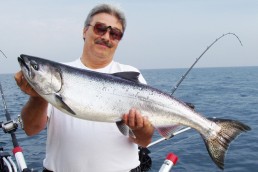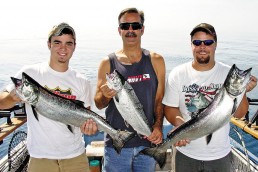Lake Michigan Salmon Fishery Improving
SHARE THIS POST
For the last 25 years Lake Michigan anglers and fishery managers have watched with dismay as invasive species, mainly zebra and quagga mussels, coated the lake’s floor, and gobbled down immense quantities of the microorganisms that form the base of the food chain. Deprived of their once abundant food supply, the forage base, mainly alewives, dwindled dramatically. The impact on the seemingly inexhaustible salmon and trout population was nothing short of devastating, and what was once thought of as lake of plenty appeared destined to become a lake of plenty of nothing.
In 1999, the fishery experts determined that the forage base could no longer support the massive stocking programs that were in place by the four Lake Michigan states and U.S. Fish and Wildlife Service. Deep cuts were made to the numbers of salmon and trout stocked, and even deeper cuts were instituted in 2013, and again in 2017.
Of the five predator species involved it was determined that the Chinook salmon was the only one that was feeding almost exclusively on alewives, and if pressure was going to be relieved on the bait fish the stocking cuts must necessarily fall on the big Kings.
To give an example of how the mighty Chinook had fallen, in 1989 lake wide stocking levels reached their high point at 19,218,000 salmon/trout, of which 7,859,000 were Chinook. In 2017, lake wide Chinook stocking had plummeted to 690,000, although clear evidence of wild spawned Chinook indicated that between 2 and 5 million fingerlings were entering the lake each spring from some Michigan rivers. Continuing surveys were being conducted to determine if further stocking cuts were needed. The future looked grim for the big salmon.
And then, in early fall the results from the bottom trawls and acoustical surveys came in, and guess what, the forage base had prospered noticeably. In fact, the resurgence, although limited, prompted the fishery managers to recommend increasing 2020 Chinook stocking numbers lake wide. Additionally, the average size of the Chinook had increased noticeably, and hundreds of fish exceeding thirty pounds had been caught. In fact, one forty pound plus whopper was verified.
Are you enjoying this post?
You can be among the first to get the latest info on where to go, what to use and how to use it!
As of this writing, in mid-October, Michigan has announced an increase of 150,000 Chinook, and Indiana is adding 87,000 to its projected 2020 planting. No word has been received from Wisconsin yet, but the odds favor a significant Chinook increase there also. Since Illinois is dependent on Wisconsin and Michigan for Chinook eggs for their hatchery, any boost in their planting may have to wait for 2021.
But, be warned not to go out dancing in the streets just yet, because fish populations are notoriously variable, and what goes up could just as quickly come down. Enjoy the good news while you can, but keep your fingers crossed.
And, here is some additional information I picked up while researching this story with Ben Dickenson, a fisheries biologist with Indiana DNR. I wondered why we had heard of all those wild Chinook pouring into the lake, but never received any reports of significant improvements in their fall returns to their natal rivers. Ben related that the bulk of these wild fish were coming out of the Betsie River, and other smaller streams far up in the northeast corner of the lake, and that those waterways were indeed experiencing large fall Chinook returns, and producing exceptional angling results.
So, sharpen your hooks, spool on some fresh line, and get ready for some thrilling battles with trophy sized Chinook out on the Big Lake next summer.
MWO
SHARE THIS POST
Did you enjoy this post?
You can be among the first to get the latest info on where to go, what to use and how to use it!
Jerry Pabst
Jerry Pabst has been writing about the outdoors for over 40 years. He captained a Lake Michigan charter boat for 25 years and was inducted into the Fresh Water Fishing Hall of Fame. He has hunted waterfowl in all North American flyways, pursued upland game extensively, and trains his own dogs.



